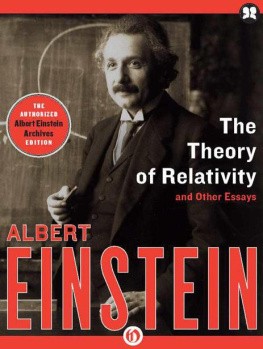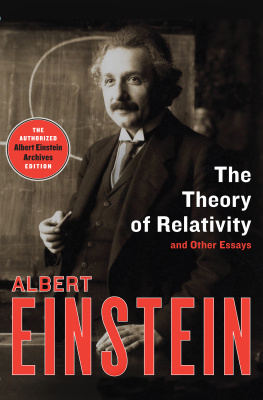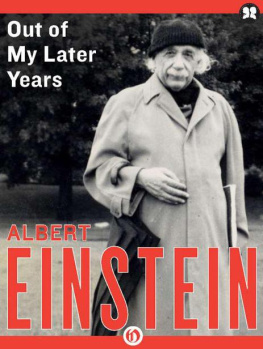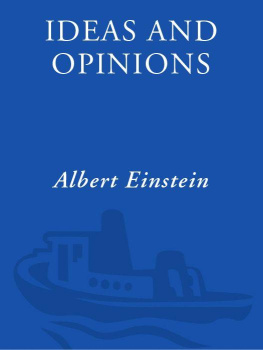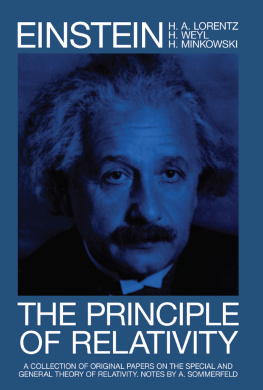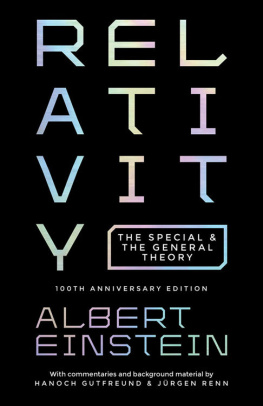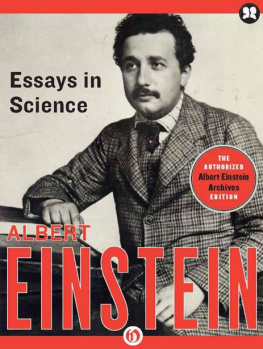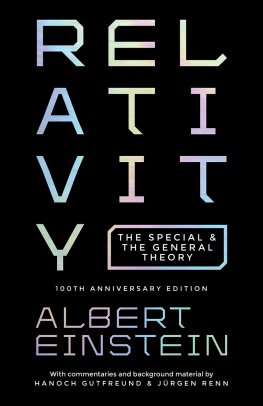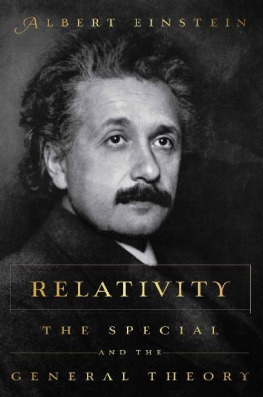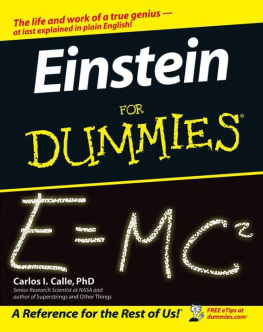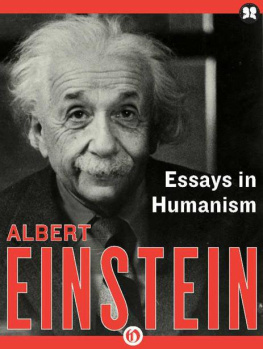Albert Einstein - The Theory of Relativity: and Other Essays
Here you can read online Albert Einstein - The Theory of Relativity: and Other Essays full text of the book (entire story) in english for free. Download pdf and epub, get meaning, cover and reviews about this ebook. year: 2011, publisher: Philosophical Library/Open Road, genre: Romance novel. Description of the work, (preface) as well as reviews are available. Best literature library LitArk.com created for fans of good reading and offers a wide selection of genres:
Romance novel
Science fiction
Adventure
Detective
Science
History
Home and family
Prose
Art
Politics
Computer
Non-fiction
Religion
Business
Children
Humor
Choose a favorite category and find really read worthwhile books. Enjoy immersion in the world of imagination, feel the emotions of the characters or learn something new for yourself, make an fascinating discovery.
- Book:The Theory of Relativity: and Other Essays
- Author:
- Publisher:Philosophical Library/Open Road
- Genre:
- Year:2011
- Rating:3 / 5
- Favourites:Add to favourites
- Your mark:
- 60
- 1
- 2
- 3
- 4
- 5
The Theory of Relativity: and Other Essays: summary, description and annotation
We offer to read an annotation, description, summary or preface (depends on what the author of the book "The Theory of Relativity: and Other Essays" wrote himself). If you haven't found the necessary information about the book — write in the comments, we will try to find it.
The Theory of Relativity: and Other Essays — read online for free the complete book (whole text) full work
Below is the text of the book, divided by pages. System saving the place of the last page read, allows you to conveniently read the book "The Theory of Relativity: and Other Essays" online for free, without having to search again every time where you left off. Put a bookmark, and you can go to the page where you finished reading at any time.
Font size:
Interval:
Bookmark:
The Theory of Relativity and Other Essays
Albert Einstein

Contents
MATHEMATICS DEALS EXCLUSIVELY with the relations of concepts to each other without consideration of their relation to experience. Physics too deals with mathematical concepts; however, these concepts attain physical content only by the clear determination of their relation to the objects of experience. This in particular is the case for the concepts of motion, space, time.
The theory of relativity is that physical theory which is based on a consistent physical interpretation of these three concepts. The name theory of relativity is connected with the fact that motion from the point of view of possible experience always appears as the relative motion of one object with respect to another (e.g., of a car with respect to the ground, or the earth with respect to the sun and the fixed stars). Motion is never observable as motion with respect to space or, as it has been expressed, as absolute motion. The principle of relativity in its widest sense is contained in the statement: The totality of physical phenomena is of such a character that it gives no basis for the introduction of the concept of absolute motion; or shorter but less precise: There is no absolute motion.
It might seem that our insight would gain little from such a negative statement. In reality, however, it is a strong restriction for the (conceivable) laws of nature. In this sense there exists an analogy between the theory of relativity and thermodynamics. The latter too is based on a negative statement: There exists no perpetuum mobile.
The development of the theory of relativity proceeded in two steps, special theory of relativity and general theory of relativity. The latter presumes the validity of the former as a limiting case and is its consistent continuation.
A. Special theory of relativity .
Physical interpretation of space and time in classical mechanics.
Geometry, from a physical standpoint, is the totality of laws according to which rigid bodies mutually at rest can be placed with respect to each other (e.g., a triangle consists of three rods whose ends touch permanently). It is assumed that with such an interpretation the Euclidean laws are valid. Space in this interpretation is in principle an infinite rigid body (or skeleton) to which the position of all other bodies is related (body of reference). Analytic geometry (Descartes) uses as the body of reference, which represents space, three mutually perpendicular rigid rods on which the coordinates (x, y, z) of space points are measured in the known manner as perpendicular projections (with the aid of a rigid unit-measure).
Physics deals with events in space and time. To each event belongs, besides its place coordinates x, y, z, a time value t. The latter was considered measurable by a clock (ideal periodic process) of negligible spatial extent. This clock C is to be considered at rest at one point of the coordinate system, e.g., at the coordinate origin (x = y = z = O). The time of an event taking place at a point P (x, y, z) is then defined as the time shown on the clock C simultaneously with the event. Here the concept simultaneous was assumed as physically meaningful without special definition. This is a lack of exactness which seems harmless only since with the help of light (whose velocity is practically infinite from the point of view of daily experience) the simultaneity of spatially distant events can apparently be decided immediately.
The special theory of relativity removes this lack of precision by defining simultaneity physically with the use of light signals. The time t of the event in P is the reading of the clock C at the time of arrival of a light signal emitted from the event, corrected with respect to the time needed for the light signal to travel the distance. This correction presumes (postulates) that the velocity of light is constant.
This definition reduces the concept of simultaneity of spatially distant events to that of the simultaneity of events happening at the same place (coincidence), namely the arrival of the light signal at C and the reading of C.
Classical mechanics is based on Galileos principle: A body is in rectilinear and uniform motion as long as other bodies do not act on it. This statement cannot be valid for arbitrary moving systems of coordinates. It can claim validity only for so-called inertial systems. Inertial systems are in rectilinear and uniform motion with respect to each other. In classical physics laws claim validity only with respect to all inertial systems (special principle of relativity).
It is now easy to understand the dilemma which has led to the special theory of relativity. Experience and theory have gradually led to the conviction that light in empty space always travels with the same velocity c independent of its color and the state of motion of the source of light (principle of the constancy of the velocity of lightin the following referred to as L-principle). Now elementary intuitive considerations seem to show that the same light ray cannot move with respect to all inertial systems with the same velocity c. The L-principle seems to contradict the special principle of relativity.
It turns out, however, that this contradiction is only an apparent one which is based essentially on the prejudice about the absolute character of time or rather of the simultaneity of distant events. We just saw that x, y, z and t of an event can, for the moment, be defined only with respect to a certain chosen system of coordinates (inertial system). The transformation of the x, y, z, t of events which has to be carried out with the passage from one inertial system to another (coordinate transformation), is a problem which cannot be solved without special physical assumptions. However, the following postulate is exactly sufficient for a solution: The L-principle holds for all inertial systems (application of the special principle of relativity to the L-principle). The transformations thus defined, which are linear in x, y, z, t, are called Lorentz transformations. Lorentz transformations are formally characterized by the demand that the expression
dx2 + dy2 + dz2 c2dt2,
which is formed from the coordinate differences dx, dy, dz, dt of two infinitely close events, be invariant (i.e., that through the transformation it goes over into the same expression formed from the coordinate differences in the new system).
With the help of the Lorentz transformations the special principle of relativity can be expressed thus: The laws of nature are invariant with respect to Lorentz-transformations (i.e., a law of nature does not change its form if one introduces into it a new inertial system with the help of a Lorentz-transformation on x, y, z, t).
The special theory of relativity has led to a clear understanding of the physical concepts of space and time and in connection with this to a recognition of the behavior of moving measuring rods and clocks. It has in principle removed the concept of absolute simultaneity and thereby also that of instantaneous action at a distance in the sense of Newton. It has shown how the law of motion must be modified in dealing with motions that are not negligibly small as compared with the velocity of light. It has led to a formal clarification of Maxwells equations of the electromagnetic field; in particular it has led to an understanding of the essential oneness of the electric and the magnetic field. It has unified the laws of conservation of momentum and of energy into one single law and has demonstrated the equivalence of mass and energy. From a formal point of view one may characterize the achievement of the special theory of relativity thus: it has shown generally the role which the universal constant c (velocity of light) plays in the laws of nature and has demonstrated that there exists a close connection between the form in which time on the one hand and the spatial coordinates on the other hand enter into the laws of nature.
Next pageFont size:
Interval:
Bookmark:
Similar books «The Theory of Relativity: and Other Essays»
Look at similar books to The Theory of Relativity: and Other Essays. We have selected literature similar in name and meaning in the hope of providing readers with more options to find new, interesting, not yet read works.
Discussion, reviews of the book The Theory of Relativity: and Other Essays and just readers' own opinions. Leave your comments, write what you think about the work, its meaning or the main characters. Specify what exactly you liked and what you didn't like, and why you think so.

